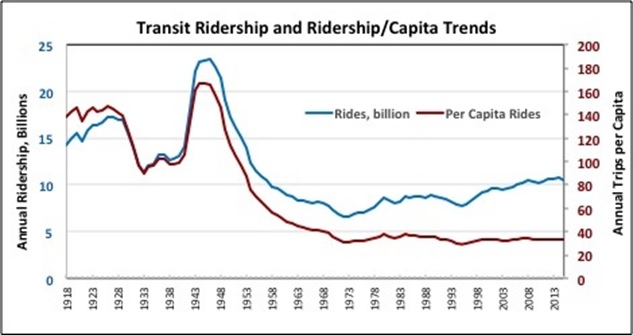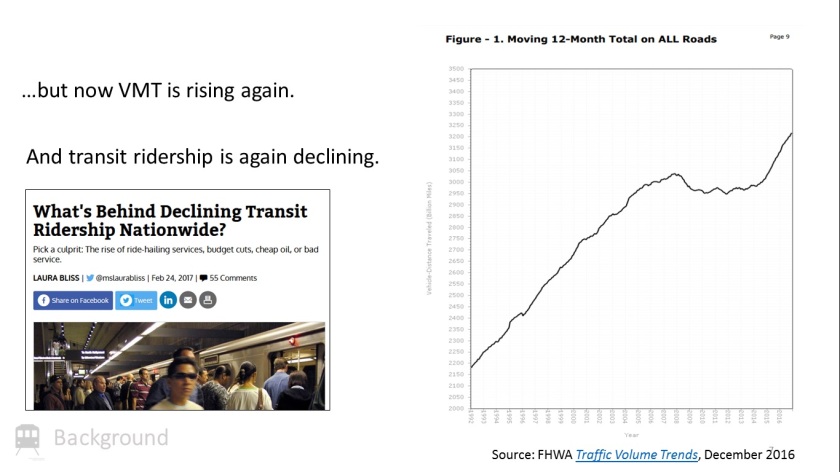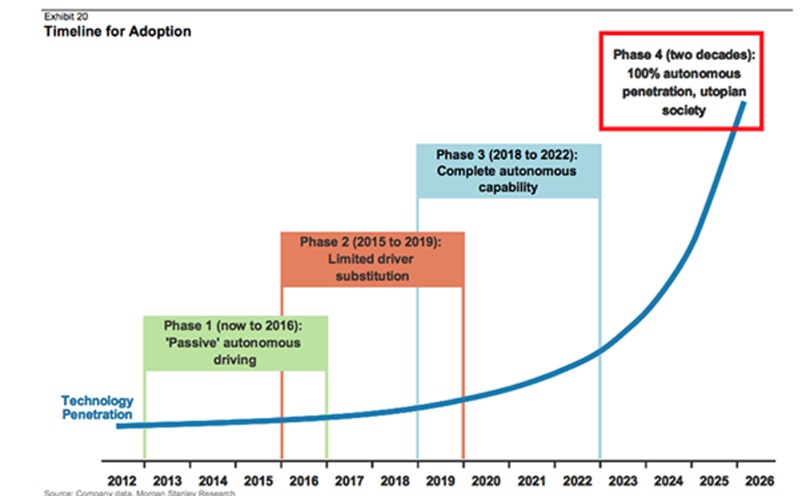I had the great pleasure of presenting a session a couple of weeks ago at the National Planning Conference in New York City, the annual planning conference put on by the American Planning Association.
Working with Shannon Greenwell at MassDOT and Patrick Sullivan at the Seaport Transportation Management Association, we put together a discussion asking the audacious and foolhardy question, what will transit look like in the year 2100? Is transit still going to be around? More importantly, should it?
It ended up being a pretty interesting discussion, with a lot of provocative ideas and a good deal of disagreement, which is exactly what we wanted. A transportation expert once said, “All traffic models are wrong, but some are useful.” That’s how we thought about this long-range planning session – we knew we were going to be wrong about our prognostications, but perhaps we could at least be useful.
Transit Barely Survived the 20th Century
The first point is that transit barely survived the 20th century. If you look at transit ridership in America, it peaked in the late 1940s and has been more or less stable, on a per capita basis, at much lower levels since then.

At the same time that transit took a plunge, car use soared. Today, in any given area except for some of the largest cities, between 75% and 85% of all work trips are made via automobile.
Many urbanists have been rejoicing at a couple of trends since 2005. Per capita car use has been on the decline, and transit ridership has been going up (if you look at the blue line in the chart above, you can see that absolute ridership has been increasing).
But over the past year many transit agencies, including PVTA, have seen year-over-year declines in fixed-route bus service. At the same time, we are starting to see the trend in car use edge back up.

Our presentation explored three key uncertainties over the next century that are going to have an incredible impact on transportation, and the future of public transit:
- Autonomous Vehicle Technology
- Climate Change Policy
- The Aging Population
These certainly aren’t the only three things that will impact our transit systems, but we focused in on them as playing an outsized role.
Autonomous Vehicle Technology
For those of you unfamiliar with Autonomous Vehicle Technology, it has the potential to change our lives, our cities, and our economy as much as automobiles did during the last century. Google, Uber, Tesla, Ford, and a lot of other firms are working on the technology to render drivers obsolete. The tech side could be complete by 2025.

This matters for transit a whole lot. A rule of thumb is that about 75% of the cost of operating a bus is paying the driver in the seat. If we didn’t have to do that anymore, then we could run buses anywhere, right?
Let’s take it a step further. Why run these buses all over the place when we can have small sedans or vans buzzing around, a la Lyft, just waiting for the next person to request a ride. Would rubber tire bus service become obsolete?
On the other hand, if we follow a private-ownership model, maybe people won’t mind traffic all that much if they get to read the paper or sleep or work on their way into town. Maybe traffic and air pollution and urban sprawl will get even worse because driving suddenly becomes “me” time or “productive” time. Would commuter rail service become obsolete?
Climate Change Policy
Another major trend in the future is climate change policy. Transit stands to benefit a lot if the US and/or the world gets serious about climate change. The energy needed to move transit, on a per capita basis, is a fraction of what it takes to move a person even in a very efficient compact car.
The wild card is whether we will ever get serious about climate change. In 2016, The Pew Center released a poll showing that about half of all Americans don’t think humans are the source of climate change – despite overwhelming scientific consensus to the contrary.

I won’t get into how depressing it is that half of my fellow citizens don’t accept climate change as something that we are causing. But the question becomes at what point, if any, will we actually get serious about climate change? And if the answer is “Never,” then will transit ever be able to compete with the ease and convenience of automobiles? Or self-driving automobiles?
Taking it a step further, it should be noted that in major cities subways are especially susceptible to sea level rise and storm surges. As climate change renders transit systems more and more unreliable (like we saw after super-storm Sandy), will we see riders abandon these systems? Will the subways that have served our cities for decades become unusable, and/or unused?
The Aging Population
Finally, the aging of the population is going to play a key role in what our transit system looks like in the future (full disclosure: this was my section, so I’ll do my best to not over-inflate its importance relative to the prior two).
I am 32 years old now; in one year, I will either be 32 years old – or dead. Those are my options; those are everyone’s options. So the average age of the population is relatively easy to forecast, using some assumptions about mortality rates. And Census Bureau has done that, showing that we’re going to increase from about 40 million people age 65 and over today, to about 80 million in 2050.
The wildcard is immigration. The Pew Research Center estimates that without immigrants, the US population will plateau at around 338 million people. Furthermore, non-native-born women are much more likely to have kids than native-born women, meaning that the 338 million Americans in a no-immigration scenario will also, on average, be pretty old.

This becomes important because older Americans are more likely to need door-to-door (paratransit) service (think those wheelchair accessible vans you see going around, “The RIDE” in Boston for example). This is due to dementia, vision loss, or any number of other impairments which make driving impossible. But as more people use paratransit service, the budget for regular “big bus” service dwindles.
As some communities become more and more dominated by senior citizens, could we imagine a transit system that only provides door-to-door service? And if the vehicles are self-driving, why not? Will big bus service even exist anymore?
Final Thoughts
I should finish by saying that I’m actually very optimistic about the future of transit. As Jarrett Walker has written about extensively in his blog and book, the simple geometry of cities and cars dictates that transit is a necessary attribute of density (just like transit depends on density, density too depends on transit). In our biggest cities, rail transit will probably never go away nor be replaceable. Cars, even self-driving cars, just take up too much space.
But on the other hand, this is an important discussion to have, especially for those places smaller than our biggest cities. In a very real sense, we as planners must be good stewards of public funding. Put bluntly, what if we build a commuter rail line that no one ever uses because they are in self-driving cars? We will have wasted millions of dollars that could have been better spent.
The discussion didn’t provide too many answers, but it did provide a lot of good questions. And if the Hitchhiker’s Guide to the Galaxy taught us nothing, it’s that finding the right question can often be the more important than the answer.
